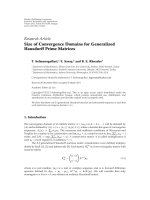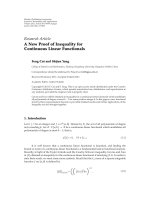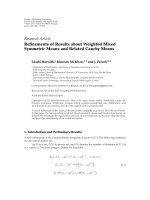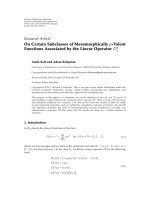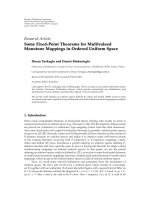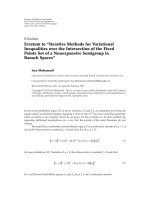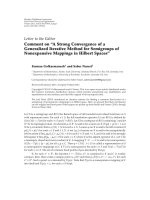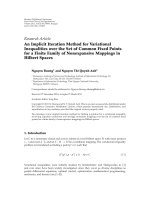Hindawi Publishing Corporation Advances in Difference Equations Volume 2011, Article ID 713201, 12 potx
Bạn đang xem bản rút gọn của tài liệu. Xem và tải ngay bản đầy đủ của tài liệu tại đây (505.14 KB, 12 trang )
Hindawi Publishing Corporation
Advances in Difference Equations
Volume 2011, Article ID 713201, 12 pages
doi:10.1155/2011/713201
Research Article
Existence Results for Nonlinear Fractional
Difference Equation
Fulai Chen,
1
Xiannan Luo,
2
and Yong Zhou
2
1
Department of Mathematics, Xiangnan University, Chenzhou 423000, China
2
School of Mathematics and Computational Science, Xiangtan University, Xiangtan 411005, China
Correspondence should be addressed to Yong Zhou,
Received 27 September 2010; Accepted 12 December 2010
Academic Editor: J. J. Trujillo
Copyright q 2011 Fulai Chen et al. This is an open access article distributed u nder the Cr eative
Commons Attribution License, which permits unrestricted use, distribution, and reproduction in
any medium, provided the original work is properly cited.
This paper is concerned with the initial value problem to a nonlinear fractional difference equation
with the Caputo like difference operator. By means of some fixed point theorems, global and local
existence results of solutions are obtained. An example is also provided to illustrate our main
result.
1. Introduction
This paper deals with the existence of solutions for nonlinear fractional difference equations
Δ
α
∗
x
t
f
t α − 1,x
t α − 1
,t∈
1−α
, 0 <α≤ 1,
x
0
x
0
,
1.1
where Δ
α
∗
is a Caputo like discrete fractional difference, f : 0, ∞ × X → X is continuous
in t and X. X, · is a real Banach space with the norm x sup{xt,t ∈ N},
1−α
{1 − α, 2 − α, }.
Fractional differential equation has received increasing attention during recent years
since fractional derivatives provide an excellent instrument for the description of memory
and hereditary properties of various materials and processes 1. However, there are few
literature to develop the theory of the analogues fractional finite difference equation 2–6.
Atici and Eloe 2 developed the commutativity properties of the fractional sum and the
fractional difference operators, and discussed the uniqueness of a solution for a nonlinear
fractional difference equation with the Riemann-Liouville like discrete fractional difference
2AdvancesinDifference Equations
operator. To the best of our knowledge, this is a pioneering work on discussing initial value
problems IVP for short in discrete fractional calculus. Anastassiou 4 defined a Caputo like
discrete fractional difference and compared it to the Riemann-Liouville fractional discrete
analog.
For convenience of numerical calculations, the fractional differential equation is
generally discretized to corresponding difference one which makes that the research about
fractional difference equations becomes important. Following the definition of Caputo like
difference operator defined in 4, here we investigate the existence and uniqueness of
solutions for the IVP 1.1. A merit of this IVP with Caputo like difference operator is that
its initial condition is the same form as one of the integer-order difference equation.
2. Preliminaries and Lemmas
We start with some necessary definitions from discrete fractional calculus theory and
preliminary results so that this paper is self-contained.
Definition 2.1 see 2, 3.Letν>0. The νth fractional sum f is defined by
Δ
−ν
f
t, a
1
Γ
ν
t−ν
sa
t − s − 1
ν−1
f
s
.
2.1
Here f is defined for s a mod 1 and Δ
−ν
f is defined for t a ν mod 1;inparticular,
Δ
−ν
maps functions defined on
a
to functions defined on
aν
,where
t
{t, t 1,t 2, }.
In addition, t
ν
Γt 1/Γt − ν 1.AticiandEloe2 pointed out that this definition of the
νth fractional sum is the development of the theory of the fractional calculus on time scales
7.
Definition 2.2 see 4.Letμ>0andm − 1 <μ<m,wherem denotes a positive integer,
m μ, · ceiling of number. Set ν m − μ.Theμth fractional Caputo like difference is
defined as
Δ
μ
∗
f
t
Δ
−ν
Δ
m
f
t
1
Γ
ν
t−ν
sa
t − s − 1
ν−1
Δ
m
f
s
, ∀t ∈ N
aν
.
2.2
Here Δ
m
is the mth order forward difference operator
Δ
m
f
s
m
k0
m
k
−1
m−k
f
s k
. 2.3
Theorem 2.3 see 4. For μ>0, μ noninteger, m μ, ν m − μ,itholds
f
t
m−1
k0
t − a
k
k!
Δ
k
f
a
1
Γ
μ
t−μ
saν
t − s − 1
μ−1
Δ
μ
∗
f
s
,
2.4
where f is defined on
a
with a ∈ N.
Advances in Difference Equations 3
In particular, when 0 <μ<1anda 0, we have
f
t
f
0
1
Γ
μ
t−μ
s1−μ
t − s − 1
μ−1
Δ
μ
∗
f
s
.
2.5
Lemma 2.4. Asolutionxt : N → X is a solution of the IVP 1.1 ifandonlyifxt is a solution
of the the following fractional Taylor’s difference formula:
x
t
x
0
1
Γ
α
t−α
s1−α
t − s − 1
α−1
f
s α − 1,x
s α − 1
, 0 <α≤ 1,
x
0
x
0
.
2.6
Proof. Suppose that xt for t ∈ N is a solution of 1.1,thatisΔ
α
∗
xtft α−1,xt α −1
for t ∈
1−α
,thenwecanobtain2.6 according to Theorem 2.3.
Conversely, we assume that xt is a solution of 2.6,then
x
t
x
0
1
Γ
α
t−α
s1−α
t − s − 1
α−1
f
s α − 1,x
s α − 1
.
2.7
On the other hand, Theorem 2.3 yields that
x
t
x
0
1
Γ
α
t−α
s1−α
t − s − 1
α−1
Δ
α
∗
x
s
.
2.8
Comparing with the above two equations, it is obtained that
1
Γ
α
t−α
s1−α
t − s − 1
α−1
Δ
α
∗
x
s
− f
s α − 1,x
s α − 1
0.
2.9
Let t 1, 2, , respectively, we have that Δ
α
∗
xtft α − 1,xt α − 1 for t ∈
1−α
,which
implies that xt is a solution of 1.1.
Lemma 2.5. One has
t−α
s1−α
t − s − 1
α−1
Γ
t α
αΓ
t
.
2.10
Proof. For x>k, x, k ∈ R, k>−1, x>−1, we have
Γ
x 1
Γ
k 1
Γ
x − k 1
Γ
x 2
Γ
k 2
Γ
x − k 1
−
Γ
x 1
Γ
k 2
Γ
x − k
, 2.11
4AdvancesinDifference Equations
that is,
Γ
x 1
Γ
x − k 1
1
k 1
Γ
x 2
Γ
x − k 1
−
Γ
x 1
Γ
x − k
. 2.12
Then
t−α
s1−α
t − s − 1
α−1
t−α
s1−α
Γ
t − s
Γ
t − s − α 1
t−α−1
s1−α
Γ
t − s
Γ
t − s − α 1
Γ
α
t−α−1
s1−α
1
α
Γ
t − s 1
Γ
t − s − α 1
−
Γ
t − s
Γ
t − s − α
Γ
α
1
α
Γ
t α
Γ
t
−
Γ
α 1
Γ
1
Γ
α
Γ
t α
αΓ
t
.
2.13
Lemma 2.6 see 2. Let ν
/
1 and assume μ ν 1 is not a nonpositive integer. Then
Δ
−ν
t
μ
Γ
μ 1
Γ
μ ν 1
t
μν
. 2.14
In particular, Δ
−ν
a aΔ
−ν
t α − 1
0
a/Γν 1t α − 1
ν
,wherea is a constant.
The following fixed point theorems will be used in the text.
Theorem 2.7 Leray-Schauder alternative theorem 8. Let E be a Banach space with C ⊆ E
closed and convex. Assume U is a relatively open subset of C with 0 ∈ U and A :
U → C is a
continuous, compact map. Then either
1 A has a fixed point in
U;or
2 there exist u ∈ ∂U and λ ∈ 0, 1 with u λu.
Theorem 2.8 Schauder fixed point theorem 9. If U is a closed, bounded convex subset of a
Banach space X and T : U → U is completely continuous, then T has a fixed point in U.
Theorem 2.9 Ascoli-Arzela theorem 10. Let X be a Banach space, and S {st} is a function
family of continuous mappings s : a, b → X.IfS is uniformly bounded and equicontinuous, a nd
for any t
∗
∈ a, b, the set {st
∗
} is relatively compact, then there exists a uniformly convergent
function sequence {s
n
t} n 1, 2, ,t∈ a, b in S.
Lemma 2.10 Mazur Lemma 11. If
S is a compact subset of Banach space X,thenitsconvex
closure
conv
S is compact.
Advances in Difference Equations 5
3. Local Existence and Uniqueness
Set N
K
{0, 1, ,K},whereK ∈ N.
Theorem 3.1. Assume f : 0,K × X → X is locally Lipschitz continuous (with constant L)onX,
then the IVP 1.1 has a unique solution xt on t ∈ N provided that
LΓ
K α
Γ
α 1
Γ
K
< 1. 3.1
Proof. Define a mapping T : X|
t∈N
K
→ X|
t∈N
K
by
Tx
t
x
0
1
Γ
α
t−α
s1−α
t − s − 1
α−1
f
s α − 1,x
s α − 1
3.2
for t ∈ N
K
. Now we show that T is contraction. For any x, y ∈ X|
t∈N
K
it follows that
Tx
t
−
Ty
t
≤
1
Γ
α
t−α
s1−α
t − s − 1
α−1
f
s α − 1,x
s α − 1
− f
s α − 1,y
s α − 1
≤
L
Γ
α
t−α
s1−α
t − s − 1
α−1
x − y
≤
LΓ
t α
αΓ
α
Γ
t
x − y
≤
L
K α
···
t α
Γ
t α
αΓ
α
K − 1
···tΓ
t
x − y
≤
LΓ
K α
Γ
α 1
Γ
K
x − y
.
3.3
By applying Banach contraction principle, T has a fixed point x
∗
t which is a unique solution
of the IVP 1.1.
Theorem 3.2. Assume that there exist L
1
,L
2
> 0 such that ft, x≤L
1
x L
2
for x ∈ X,and
the set
S {t − s − 1
α−1
fs α − 1,xs α − 1 : x ∈ X, s ∈{1 − α, ,t− α}} is relatively
compact for every t ∈ N
K
, then there exists at least one solution xt of the IVP 1.1 on t ∈ N
K
provided that
L
1
Γ
K α
Γ
α 1
Γ
K
< 1. 3.4
Proof. Let T be the operator defined by 3.2, we define the set E as follows:
E
{
x
t
:
x
t
≤ M 1,t∈ N
K
}
, 3.5
6AdvancesinDifference Equations
where
M
Γ
α 1
Γ
K
x
0
L
2
Γ
K α
Γ
α 1
Γ
K
− L
1
Γ
K α
. 3.6
Assume that there exist x ∈ E and λ ∈ 0, 1 such that x λTx. We claim that x
/
M
1. In fact,
x
t
λx
0
λ
Γ
α
t−α
s1−α
t − s − 1
α−1
f
s α − 1,x
s α − 1
,
3.7
then
x
t
≤
x
0
1
Γ
α
t−α
s1−α
t − s − 1
α−1
f
s α − 1,x
s α − 1
≤
x
0
1
Γ
α
t−α
s1−α
t − s − 1
α−1
L
1
x
L
2
≤
x
0
L
1
Γ
K α
Γ
α 1
Γ
K
x
L
2
Γ
K α
Γ
α 1
Γ
K
.
3.8
We have
x
≤
x
0
L
1
Γ
K α
Γ
α 1
Γ
K
x
L
2
Γ
K α
Γ
α 1
Γ
K
. 3.9
that is,
x
≤
Γ
α 1
Γ
K
x
0
L
2
Γ
K α
Γ
α 1
Γ
K
− L
1
Γ
K α
M, 3.10
which implies that x
/
M 1.
The operator T is continuous because that f is continuous. In the following, we prove
that the operator T is also completely continuous in E.Foranyε>0, there exist t
1
,t
2
∈
N
K
t
1
>t
2
such that
t
1
α − 1
···
t
2
α
t
1
− 1
···t
2
− 1
<
Γ
K
Γ
α
L
1
M L
2
Γ
K α
ε, 3.11
Advances in Difference Equations 7
then we have
Tx
t
1
−
Tx
t
2
1
Γ
α
t
1
−α
s1−α
t
1
− s − 1
α−1
f
s α − 1,x
s α − 1
−
t
2
−α
s1−α
t
2
− s − 1
α−1
f
s α − 1,x
s α − 1
≤
1
Γ
α
t
2
−α
s1−α
t
1
− s − 1
α−1
−
t
2
− s − 1
α−1
f
s α − 1,x
s α − 1
1
Γ
α
t
1
−α
st
2
−α1
t
1
− s − 1
α−1
f
s α − 1,x
s α − 1
≤
L
1
M L
2
Γ
α
t
2
−α
s1−α
t
1
− s − 1
α−1
−
t
2
−α
s1−α
t
2
− s − 1
α−1
L
1
M L
2
Γ
α
t
1
−α
st
2
−α1
t
1
− s − 1
α−1
L
1
M L
2
αΓ
α
Γ
t
1
α
Γ
t
1
−
Γ
t
1
− t
2
α
Γ
t
1
− t
2
−
Γ
t
2
α
Γ
t
2
Γ
t
1
− t
2
α
Γ
t
1
− t
2
L
1
M L
2
αΓ
α
Γ
t
1
α
Γ
t
1
−
Γ
t
2
α
Γ
t
2
L
1
M L
2
αΓ
α
Γ
t
2
α
Γ
t
2
Γ
t
1
α
Γ
t
2
Γ
t
1
Γ
t
2
α
− 1
≤
L
1
M L
2
αΓ
α
Γ
K α
Γ
K
t
1
α − 1
···
t
2
α
t
1
− 1
···t
2
− 1
<ε,
3.12
which means that the set TE is an equicontinuous set.
In view of Lemma 2.10 and t he condition that
S is relatively compact, we know that
conv
S is compact. For any t
∗
∈ N
K
,
Tx
n
t
∗
x
0
1
Γ
α
t
∗
−α
s1−α
t
∗
− s − 1
α−1
f
s α − 1,x
n
s α − 1
x
0
1
Γ
α
ξ
n
,
3.13
where
ξ
n
t
∗
−α
s1−α
t
∗
− s − 1
α−1
f
s α − 1,x
n
s α − 1
.
3.14
8AdvancesinDifference Equations
Since
conv
S is convex and compact, we know that ξ
n
∈ conv
S.Hence,foranyt
∗
∈ N
K
,theset
{Tx
n
t
∗
} n 1, 2, is relatively compact. From Theorem 2.9,every{Tx
n
t} contains
a uniformly convergent subsequence {Tx
n
k
t} k 1, 2, on N
K
which means that the
set TE is relatively compact. Since TE is a bounded, equicontinuous and relatively compact
set, we have that T is completely continuous.
Therefore, the Leray-Schauder fixed point theorem guarantees that T has a fixed point,
which means that there exists at least one solution of the IVP 1.1 on t ∈ N
K
.
Corollary 3.3. Assume that there exist M>0 such that ft, x≤M for any t ∈ 0,K and
x ∈ X, and the set
S {t − s − 1
α−1
fs α − 1,xs α − 1 : x ∈ X, s ∈{1 − α, ,t− α}}
is relatively compact for every t ∈ N
K
, then there exists at least one solution of the IVP 1.1 on
t ∈ N
K
.
Proof. Let L
1
0, L
2
M, we directly obtain the result by applying Theorem 3.2.
Corollary 3.4. Assume that the function f satisfies lim
x→0
ft, x/x 0, and the set
S
{t − s − 1
α−1
fs α − 1,xs α − 1 : x ∈ X, s ∈{1 − α, ,t− α}} is relatively com pact for
every t ∈ N
K
, then there exists at least one solution of the IVP 1.1 on t ∈ N
K
.
Proof. According to lim
x→0
ft, x/x 0, for any ε>0, there exists P>0suchthat
ft, x≤εP for any x≤P.LetM εP,thenCorollary 3.4 holds by Corollary 3.3.
Corollary 3.5. Assume the function F : R
→ R
is nondecreasing continuous and there exist L
3
,
L
4
> 0 such that
f
t, x
≤ L
3
F
x
L
4
,t∈
0,K
, 3.15
lim
u → ∞
F
u
< ∞,
3.16
and the set
S {t − s − 1
α−1
fs α − 1,xs α − 1 : x ∈ X, s ∈{1 − α, ,t− α}} is relatively
compact for every t ∈ N
K
, then there exists at least one solution of the IVP 1.1 on t ∈ N
K
.
Proof. By inequity 3.16, there exist positive constants R
1
,d
1
,suchthatFu ≤ R
1
,forallu ≥
d
1
.LetR
2
sup
0≤u≤d
1
Fu.ThenwehaveFu ≤ R
1
R
2
,forallu ≥ 0. Let M L
3
R
1
R
2
L
4
,
then Corollary 3.5 holds by Corollary 3.3.
4. Global Uniqueness
Theorem 4.1. Assume f : 0, ∞ × X → X is globally Lip schitz continuous (with constant L)on
X, then the IVP 1.1 has a unique solution xt provided that 0 <L<1/1 α.
Proof. For t ∈{0, 1},letT : X → X be the operator defined by 3.2.Foranyx, y ∈ X it
follows that
Advances in Difference Equations 9
Tx
t
−
Ty
t
≤
1
Γ
α
t−α
s1−α
t − s − 1
α−1
f
s α − 1,x
s α − 1
− f
s α − 1,y
s α − 1
≤
L
Γ
α
α − 1
α−1
x − y
L
Γ
α
Γ
α
x − y
L
x − y
.
4.1
Since L<1/1 α < 1, by applying Banach contraction principle, T has a fixed point x
1
t
which is a unique solution of the IVP 1.1 on t ∈{0, 1}.
Since x
1
1 exists, for t ∈{1, 2}, we may define the following mapping T
1
: X → X:
T
1
x
t
x
1
1
1
Γ
α
t−α
s1−α
t − s − 1
α−1
f
s α − 1,x
s α − 1
.
4.2
For any x, y ∈ X, t ∈{1, 2},wehave
T
1
x
t
−
T
1
y
t
≤
1
Γ
α
t−α
s1−α
t − s − 1
α−1
f
s α − 1,x
s α − 1
− f
s α − 1,x
s α − 1
≤
L
Γ
α
t−α
s1−α
t − s − 1
α−1
x − y
≤
L
Γ
α
2−α
s1−α
2 − s − 1
α−1
x − y
L
Γ
α
α
α−1
α − 1
α−1
x − y
L
Γ
α
Γ
α 1
Γ
2
Γ
α
Γ
1
x − y
L
1 α
x − y
.
4.3
Since L1 α < 1, by applying Banach contraction principle, T
1
has a fixed point x
2
t which
is a unique solution of the IVP 1.1 on t ∈{1, 2}.
In general, since x
m
m exists, we may define the operator T
m
as follows
T
m
x
t
x
m
m
1
Γ
α
t−α
sm−α
t − s − 1
α−1
f
s α − 1,x
s α − 1
4.4
10 Advances in Difference Equations
for t ∈{m, m 1}. Similar to the deduction of 4.3, we may obtain that the IVP 1.1 has a
unique solution x
m1
t on t ∈{m, m 1},thenx
m1
m 1 exists.
Define xt as follows
x
t
⎧
⎪
⎪
⎪
⎪
⎪
⎪
⎪
⎪
⎪
⎪
⎪
⎪
⎨
⎪
⎪
⎪
⎪
⎪
⎪
⎪
⎪
⎪
⎪
⎪
⎪
⎩
x
0
,t 0,
x
1
t
,t 1,
.
.
.
x
m
t
,t m,
.
.
.
4.5
then xt is the unique solution of 1.1 on t ∈ N.
5. Example
Example 5.1. Consider the fractional difference equation
Δ
α
∗
x
t
λx
t α − 1
,t∈
1−α
, 0 <α≤ 1,
x
0
x
0
.
5.1
According to Theorem 4.1,theIVP5.1 has a unique solution xt provided that λ<1 /1α.
In fact, we can employ the method of successive approximations to obtain the solution of
5.1.
Set
x
0
t
x
0
,
x
m
t
x
0
t
λ
Γ
α
t−α
s1−α
t − s − 1
α−1
x
m−1
s α − 1
x
0
t
λΔ
−α
x
m−1
t α − 1
,m 1, 2,
5.2
Applying Lemma 2.6,wehave
x
1
t
x
0
t
λΔ
−α
x
0
t α − 1
x
0
λΔ
−α
x
0
x
0
1
λ
Γ
α 1
t α − 1
α
.
5.3
Advances in Difference Equations 11
By induction, it follows that
x
m
t
x
0
m
i0
λ
i
Γ
iα 1
t i
α − 1
iα
,m 1, 2,
5.4
Taking the limit m →∞,weobtain
x
t
x
0
∞
i0
λ
i
Γ
iα 1
t i
α − 1
iα
5.5
which is the unique solution of 5.1.Inparticular,whenα 1, the IVP 5.1 becomes the
following integer-order IVP
Δx
t
λx
t
,t∈ N,
x
0
x
0
,
5.6
whichhastheuniquesolutionxt1 λ
t
x
0
. At the same time, 5.5 becomes that
x
t
x
0
∞
i0
λ
i
i!
t
i
1 λ
t
x
0
.
5.7
Equation 5.7 implies that, when α 1, the result of the IVP 5.5 is the same as one of the
corresponding integer-order IVP 5.6.
Remark 5.2. Example 5.1 is similar to Example 3.1 in 2 in which the difference operator is in
the Riemann-Liouville like discrete sense. Compared with the solution of Example 3.1 in 2
defined on
α−1
,where
α−1
{α − 1,α,α 1, }, the solution of Example 5.1 in this paper is
defined on N.Thisdifference makes that fractional difference equation with the Caputo like
difference operator is more similar to classical integer-order difference equation.
Acknowledgments
This work was supported by the Natural Science Foundation of China 10971173,the
Scientific Research Foundation of Hunan Provincial Education Department 09B096,the
Aid Program for Science and Technology Innovative Research Team in Higher Educational
Institutions of Hunan Province, and the Construct Program of the Key Discipline in Hunan
Province.
References
1 I. Podlubny, Fractional Differential Equations, vol. 198 of Mathematics i n Science and Engineering,
Academic Press, San Diego, Calif, USA, 1999.
2 F. M. Atici and P. W. Eloe, “Initial value problems in discrete fractional calculus,” Proceedings of the
American Mathematical Society, vol. 137, no. 3, pp. 981–989, 2009.
12 Advances in Difference Equations
3 F. M. Atici and P. W. Eloe, “A transform method in discrete fractional calculus,” International Journal
of Difference Equations, vol. 2 , no. 2, pp. 165–176, 2007.
4 G. A. Anastassiou, “Discrete fractional calculus and inequalities,” />5 F. M. A tıcı and P. W. Eloe, “Discrete fractional calculus with the nabla operator,” Electronic Journal of
Qualitative Theory of Differential Equations, vol. 2009, no. 3, pp. 1–12, 2009.
6 F. M. Atıcı and S. S¸eng
¨
ul, “Modeling with fractional difference equations,” Journal of Mathematical
Analysis and Applications, vol. 369, no. 1, pp. 1–9, 2010.
7 M. Bohner and A . Peterson, Dynamic Equations on Time Scales,Birkh
¨
auser, Boston, Mass, USA, 2001.
8 A. Granas, R. B. Guenther, and J. W. Lee, “Some general existence principles in the Carath
´
eodory
theory of nonlinear differential systems,” Journal de Math
´
ematiques Pures et Appliqu
´
ees, vol. 70, no. 2,
pp. 153–196, 1991.
9 J. Hale, Theory of Functional Differential Equations, vol. 3 of Applied Mathematical Sciences,Springer,New
York, NY, USA, 2nd edition, 1977.
10 V. Lakshmikantham and S. Leela, Nonlinear Differential Equations in Abstract Spaces, vol. 2 of
International Series in Nonlinear Mathematics: Theory, Methods and Applications, Pergamon Press, Oxford,
UK, 1981.
11 W. Rudin, Functional Analysis, McGraw-Hill Series in Higher Mathematics, McGraw-Hill, New York,
NY, USA, 1973.
